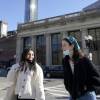Two days after President Joe Biden kicked up a controversy about the longevity of the COVID pandemic, I became a statistic. I tested positive for COVID-19. I thought I had a bad head cold, maybe the flu — but not COVID.
How could I? I managed to avoid contracting the virus through the height of the pandemic before vaccines were available in 2020 and the early part of 2021. And I avoided it again while waiting to get the latest booster. I’ve been a diligent mask-wearer, even at my office where there is no longer a mask mandate. Plus, I’ve ventured out carefully — gathering in person in places where everybody else was vaxxed, boosted and mask-wearing. For three years, my diligence has kept me COVID free, while people all around me were struck.
It’s been weird to review the data report reported weekly in the Massachusetts Department of Public Health Data at a glance, and know my COVID test is one of just over 9,000 confirmed cases. The online dashboard breaks down the data: 245 hospitalizations because of COVID, 30 more than last week. There were 41 deaths. A friend who got COVID the same time I did reminded me that, without the protective medicines, both he and I would have suffered through much more than the 100-degree temperatures, pounding headaches and chest-racking coughs.
More Commentary
We are the evidence that even a pandemic that may seem to be on the wane is actually still quite active. Consequently, there was swift public backlash when President Biden told CBS’ “60 Minutes,” “We still have a problem with COVID ... but the pandemic is over.” First, from the scientists and doctors in the middle of advocating for the latest COVID booster designed for the highly contagious omicron variant. The one booster I haven’t gotten yet. And from the president’s political critics who demanded to know why — if he thought the pandemic was over — he was lobbying for $22 billion more to pay for ongoing COVID emergency measures, including tests and vaccines.
It’s puzzling to me that the president, who has succumbed to COVID twice, would so casually dismiss the virus’ current and ongoing potent threat. But I’m guessing it was his eagerness to talk about the normalcy of living with COVID.
The recent Axios/Ipsos poll reflects that belief, revealing that two out of three Americans think there is either a small or no risk in returning to pre-COVID activities like in-person gatherings and vacations. But, all along we’ve rushed the process — prematurely dismissing physical distancing and mask-wearing, the extra protective measures which secure a new normal.
I am not comforted by the latest guidance from the Centers for Disease Control that hospitals and nursing homes in areas of low transmission can stop masking. This doesn’t, by the way, include Massachusetts — where, as I now know firsthand, the COVID spread is still high.
Once more for the people in the back: the pandemic is not over. And as anyone who’s ever watched a TV thriller knows, the bad guy is most dangerous in the final throes of his life.









